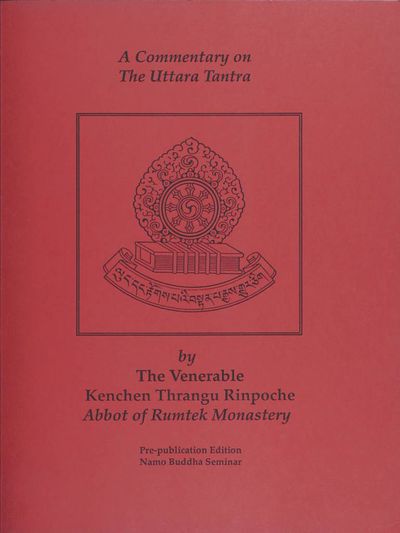- 1. Introduction to the Uttara Tantra 1
- 2. The Buddha 21
- 3. The Dharma 28
- 4. The Sangha 39
- 5. Introduction to Book II 50
- 6. Buddha Nature (The 10 Aspects) 55
- 7. Buddha Nature (The 9 Examples) 85
- 8. Enlightenment (1-5 Aspects) 102
- 9. Enlightenment (6-10 Aspects) 121
- 10. The Qualities of Buddhahood 150
- 11. Buddha Activity 170
- 12 The Benefits of the Text 185
- Appendix A: Technical Terms 197
- Appendix B: Spellings of Tibetan words 208
- Appendix C: Biography of Thrangu Rinpoche 211
A Commentary on The Uttara Tantra
In 1981 Kagyu Samye Ling in Scotland invited the Venerable Thrangu Rinpoche to give some Buddhist teachings. He chose to give commentaries on some of the important texts of the Kagyü sect of Tibetan buddhism and spent several months giving a line by line commentary on the Uttara Tantra and then answering the questions of the students.
The Uttara Tantra was written in the fourth century AD by Asaṅga and was brought to Tibet and translated into Tibetan. This was before the Muslim invasion of India which caused the destruction of most Buddhist texts in India. This text of 400 verses is devoted entirely to the study of buddha nature—that primary essence that all beings possess and that quality which makes it possible for all beings to achieve enlightenment. In the Kagyü tradition the verses of the Uttara Tantra are often memorized and studied before entering a three-year meditation retreat. Needless to say, this text is extremely relevant for all Buddhist practitioners and answers many of the questions Western students have, namely, how one can tell if someone is enlightened and what is necessary to achieve this state.
Ken and Katia Holmes, working off the tapes of Thrangu Rinpoche's teachings, were able to translate the "root text", that is the 400 verses of the Uttara Tantra, and the results of their efforts are found in their excellent book The Changeless Nature. However, like most Buddhist texts of the period, the Uttara Tantra was written in very terse, compact language with extremely deep and subtle references which makes the text accessible to only an extremely great scholar such as Thrangu Rinpoche. So the need for a commentary arose, and at the suggestion of Thrangu Rinpoche, the 14 audio tapes of the English translation of Rinpoche's commentary were transcribed and used for this commentary. These tapes follow an oral tradition used by lamas of Tibet for the last thousand years in which every point is numbered, placed in a category, stated, restated, emphasized, and then summarized. Had the transcripts simply been typeset, the commentary would have been about 700 pages long and would have been almost impossible to read. So with the help of chapters, headings, and extensive elimination of repetition and categorization, the Commentary on the Uttara Tantra was brought down to a manageable size and changed into a work which could be read by Westerners. At the suggestion of Ken Holmes the numbers of the verses in the Changeless Nature are given in brackets before the corresponding paragraphs of the commentary so one can read the verses of the Changeless Nature and then read the corresponding commentary. Two appendices were also added so that readers not familiar with Buddhist terms can easily look them up. An attempt was also made to make the commentary clear enough so that the reader could read it and learn from it without having to keep referring to the root text. (Clark Johnson, foreword)
| Citation | Thrangu Rinpoche. A Commentary on The Uttara Tantra. Translated by Ken Holmes and Katia Holmes. Boulder, CO: Namo Buddha Seminar, 1989. |
|---|---|
- Oral teachings given by Thrangu Rinpoche at Kagyu Samye Ling in Scotland in the 1970s on the Uttaratantrashastra, based on the commentary by 'jam mgon kon sprul.

